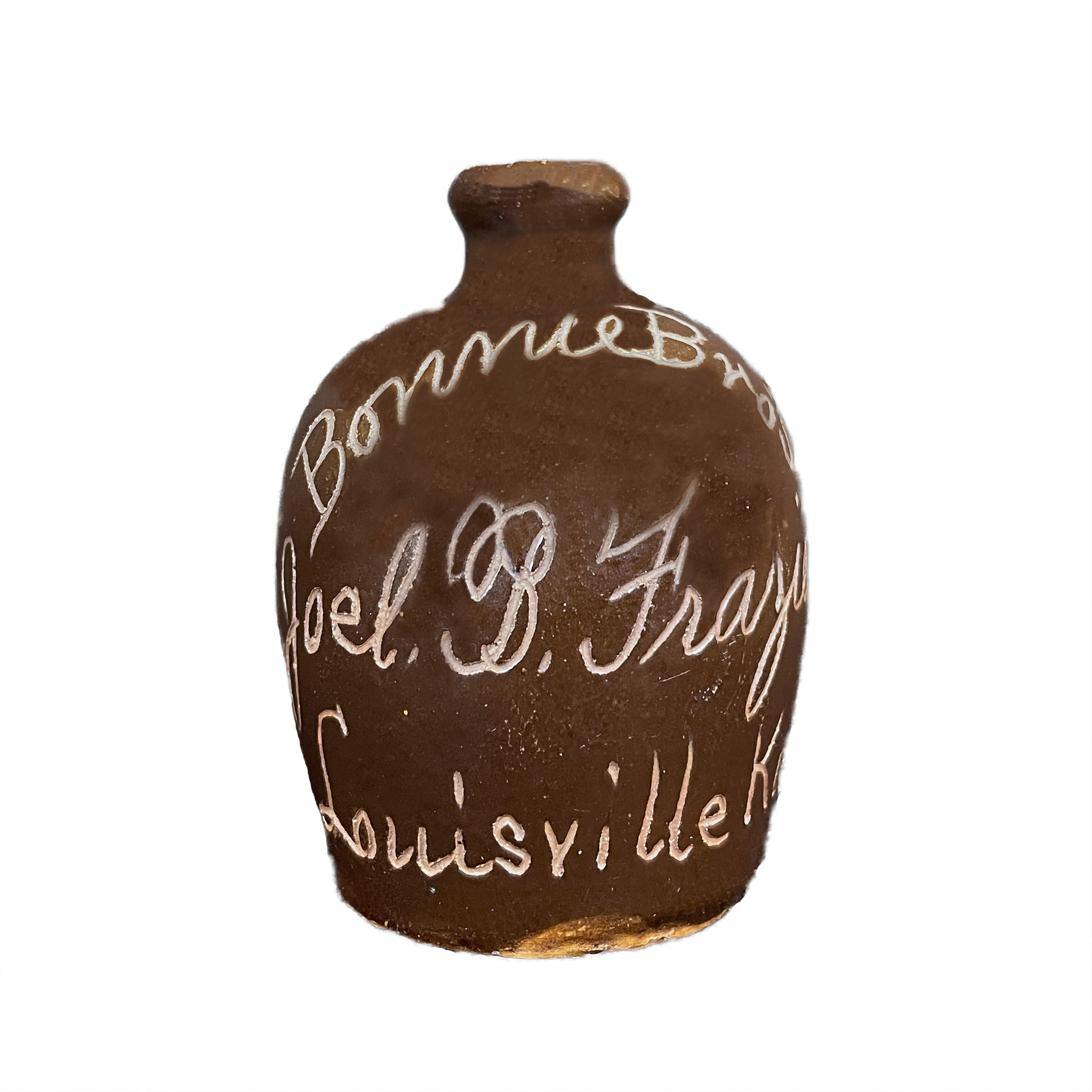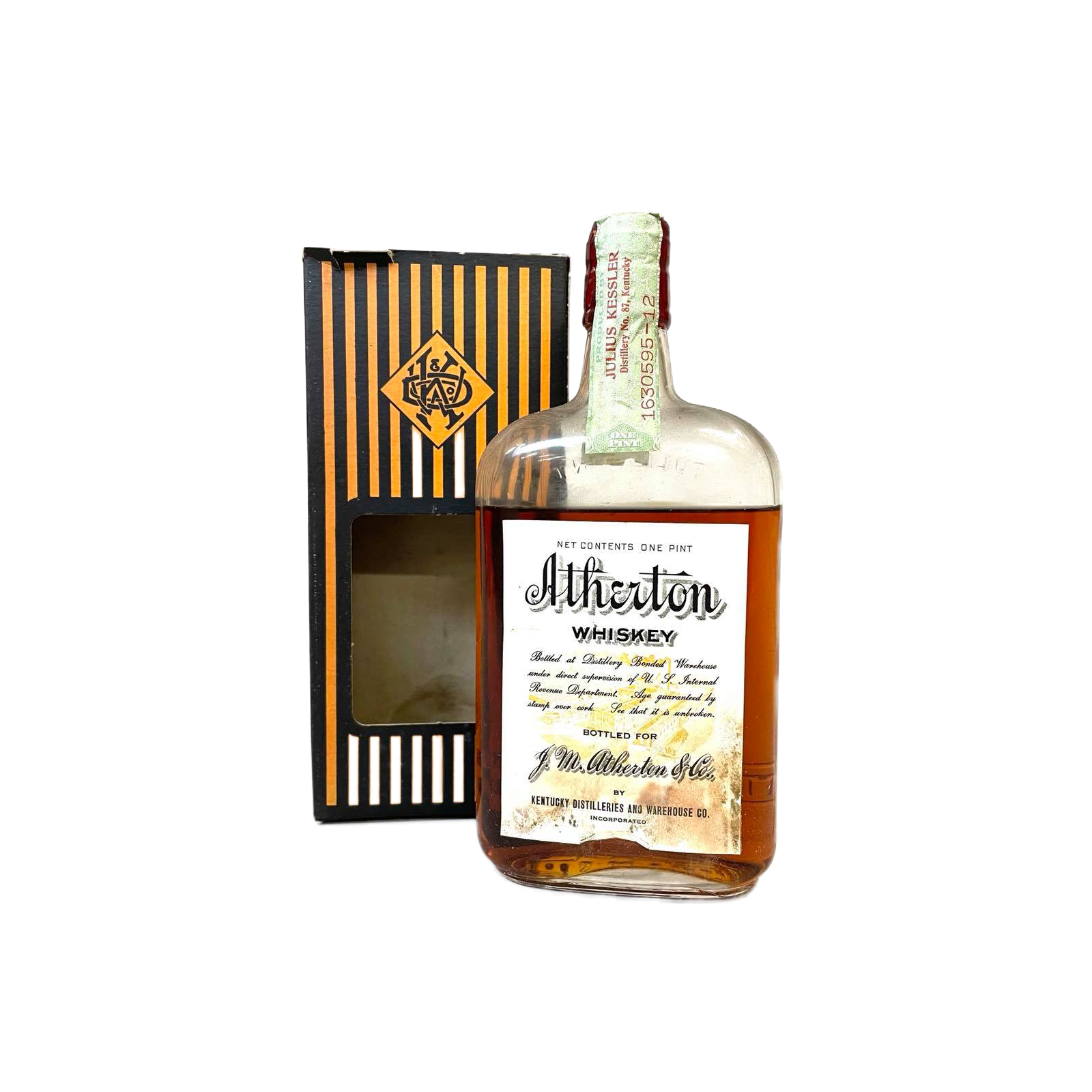Bourbon History Collection
Artifacts that relate to the history of distilling, distributing, and advertising Kentucky Bourbon whiskey.
Atherton Whiskey, 1929
J.M Atherton & Co. (1867-1933). Kentucky Straight Bourbon Whiskey bottle, distilled 1917 and bottled in 1929 for J.M. Atherton & Co. by Kentucky Distilleries and Warehouse Co. Incorporated. Produced by Julius Kessler, Distillery No. 87, Kentucky.
The J.M. Atherton & Co. distillery was established in 1867 by John McDougal Atherton, a native of LaRue County, Kentucky and a third-generation whiskey distiller. Throughout its operation at the turn of the century, the distillery produced many brands of whiskey including Atherton Whiskey, Atherton Old Fashioned, and Mayfield. The company headquarters joined the historic “whiskey row” on Main Street in Louisville in 1882, where this particular bottle was distilled over thirty years later.
Shortly after the Bottled-in-Bond Act of 1897, John M. Atherton transferred the entirety of his brand and operations to the Kentucky Distilleries and Warehouse Company of the government-regulated Whiskey Trust. This bottle is particularly interesting for the dramatic changes that occurred in the bourbon industry during its aging period. Though distilled in 1917 when Chicago businessman Julius Kessler managed production for the Atherton brand, this bourbon was bottled twelve years later in the spring of 1929, when the only whiskey going into bottles was solely for medicinal purposes. The American Medicinal Spirits Company produced medicinal whiskey such as this under the Atherton brand, specifically in one-pint bottles.
Bourbon production resumed at the original Athertonville distillery in New Haven, Kentucky in 1935 under the Cummings Distillery Corporation of Athertonville, but most of the former Atherton distilleries did not survive the decade of prohibition. This bottle uniquely carries a dual identity, one of the thriving pre-prohibition era in Louisville as well as the carefully regulated period of medicinal spirits.
Wolff Distillery Advertising Jug, c. 1882-1906
In 1855, Henry Wolff arrived in Louisville, Kentucky after a brief period in New Orleans. Wolff originally came to the United States from Alsace, France, and traveled to Louisville to join his brother, Joseph, who had already established a hotel on Market Street.
The Wolff Hotel featured billiards rooms and a “sample room”, which can be imagined as something between a bistro and a bar. In essence, a place to drink and purchase fine Kentucky whiskey. The brothers soon realized there was money to be made selling whiskey, so in 1858 they sold the hotel and focused solely on a wholesale liquor business called the Wolff Distillery Company.
Throughout the 19th century, Kentucky whiskey was largely transported and sold in ceramic jugs such as the one shown here before glass became popular. They typically included branding to advertise the product. “Nonpareil Whiskey” was Wolff’s own brand, sourced from the Spring Hill Distillery located on the Kentucky River in Franklin County.
At some point Henry was no longer in business with his brother and operated the company on his own. This jug is from 1882-1906, after Henry Wolff relocated the Wolff Distillery to 638-640 Market Street. A prominent whiskey merchant for half a century, Wolff was known as one of the oldest wholesale whiskey dealers in Louisville upon his death in 1906.
Kentucky Bourbon Whiskey Pre-Prohibition Advertising Jugs, 1818-1920

Neat-Richardson Drug Co. Incorporated, Wholesale Druggists, Louisville, KY

Nock & Snyder, Market & Second Sts, Louisville, KY

Wolff Distillery Co. Kentucky's Nonpareil Whiskey, 638-640 W. Market, Est. 1858, Louisville, KY.

"Old Joe" Oldest Distillery in Anderson Co., Founded 1818, McBrayer, KY.

Old Breckenridge Whisky, L.D. Addison Dist. Louisville, KY.

Henry Bosquet's Old Blue House McKenna Whiskey, 131 S. Fourth Ave. Louisville, KY.

Take a Smile with Ames of Owensboro

Old Style R.H. Parker Nelson Co., N.M. Uri & Co., Louisville, KY.

Compliments I.W. Harper, Nelson Co Kentucky

Bonnie Bros., Joel B. Frazier, Louisville KY.

IW Harper, Nelson Co Ky Whiskey

B&H John Hopkins

Old Fortuna, Kentucky's Best Whisky, The Phil. Hollenbach Co., Louisville, KY.

George Woelflin, Cor. Campbell & Washington Sts., Louisville, KY.

Hand Made International Sour Mash N.M. Uri & Co., Louisville, KY.

Fortuna Whisky Phil. Hollenbach & Co., Louisville, KY.

The O.L. Gregory Vinegar Co. Elko County Pure Apple Juice Vinegar, Paducah, KY.

Henry Bosquet's Old Blue House McKenna Whiskey, 131 S. Fourth Ave., Louisville, KY.

Zapp's, 324 W. Market St., Louisville, KY.

Pure Fulton Whiskey, Myers and Company, Covington, KY.



